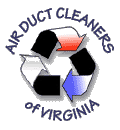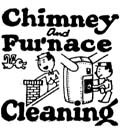| About ADCV | Services | Industry Links | Request Info | Contact Info | Homepage | ||||||||


![[Blue Ribbon Campaign icon]](br.gif) 
|
A HISTORICAL PERSPECTIVE OF AIR DUCT CLEANING It is important to realize that air duct cleaning is more than just cleaning the air ducts. Air duct cleaning must also include cleaning of the air handling unit (AHU), the return air system - - every component of the air distribution system.  In the past, most of the air duct cleaning work was for
residential customers, and was performed with
truck-mounted systems with huge canvas
vacuum bags, The air duct cleaner would hook
up a hose from the truck to the furnace and
attempt to " suck all the dust and debris
out of the system ". This practice was
ineffective at best since it is virtually
impossible to vacuum debris from one single
point without some means of agitation, like
air washing or power brushing.
In the past, most of the air duct cleaning work was for
residential customers, and was performed with
truck-mounted systems with huge canvas
vacuum bags, The air duct cleaner would hook
up a hose from the truck to the furnace and
attempt to " suck all the dust and debris
out of the system ". This practice was
ineffective at best since it is virtually
impossible to vacuum debris from one single
point without some means of agitation, like
air washing or power brushing.
This is not to say that all duct cleaners were making one connection and essentially scamming the customer. Many companies took the time to cut a series of access points in the duct system which enabled them to perform a reasonably quality job, given the limitations of the knowledge, traning and equipment available at the time.  Due to an increase in indoor air quality awareness, several
vacuum-truck and portable equipment
manufacturers emerged. The industry's limited
advancements to that point included electric
hand-held blowers (leaf Blowers) to assist in
dislodging loose dirt from the extreme ends of
the ductwork system. However these blowers
only served to move loose debris a few feet.
Air compressors were introduced as a more
effective alternative to portable blowers.
Their increased air pressure and velocity
provided a means to loosen and move the
contaminants within an air duct system to a
point where they could be vacuumed. Their use
was followed by the development and use of air
skippers or rotary sweeps.
Due to an increase in indoor air quality awareness, several
vacuum-truck and portable equipment
manufacturers emerged. The industry's limited
advancements to that point included electric
hand-held blowers (leaf Blowers) to assist in
dislodging loose dirt from the extreme ends of
the ductwork system. However these blowers
only served to move loose debris a few feet.
Air compressors were introduced as a more
effective alternative to portable blowers.
Their increased air pressure and velocity
provided a means to loosen and move the
contaminants within an air duct system to a
point where they could be vacuumed. Their use
was followed by the development and use of air
skippers or rotary sweeps.
The skipper consists of a machined ball with a series of holes attached to the end of a long flexible air hose. By triggering compressed air into this device, the skipper propels itself through ducts while air washing them at the same time. Today compressed air washing is augmented by manual scrubbing with brushes and flexible rods, as well as powered rotary brushes. These technologies allow contractors to effectively clean hard to reach areas within the duct system.  In addition to air duct cleaning being
recognized as a standard mechanical practice,the Environmental Protection Agency
(EPA) recently published preliminary recommendations on Air
Duct Cleaning in its Building Air Quality
handbook. The EPA's recommendations include
the following:
In addition to air duct cleaning being
recognized as a standard mechanical practice,the Environmental Protection Agency
(EPA) recently published preliminary recommendations on Air
Duct Cleaning in its Building Air Quality
handbook. The EPA's recommendations include
the following:
 The Environmental Protection Agency (EPA) also released a study on in October 1996,
Indoor Air Quality - Basics for Schools.
covering topics effecting the health of our children in public schools.
The Environmental Protection Agency (EPA) also released a study on in October 1996,
Indoor Air Quality - Basics for Schools.
covering topics effecting the health of our children in public schools.
The Department of Energy (DOE) published a summary of sceintific research in January 1999, Causes of Indoor Air Quality Problems in Schools futher supporting the need to take Indoor Air Quality as a serious health issue. Today, a combination of improved equipment and training along with an ever growing number of contractors getting into the business, has helped emerge the air duct cleaning industry so that it is recognized for its benefits towards improving Indoor Air Quality (IAQ). In addition to air duct cleaning, there are several other areas where the IAQ contractor has entered into this new marketplace. These include educating Builders and Real Estate Professionals as to the importance of indoor air quality, not only as a health consideration, but as an effective marketing tool to promote customer satisfaction and retention. Testing and Monitoring Services, IAQ Management Services, and equipment sales of products designed to enhance indoor air quality, such as Energy Recovery Ventilators (air-to-air heat exchangers), high efficiency filters and humidifiers have emerged. What ever your interest in Indoor Air Quality might be, it is important that you recognize the NATIONAL AIR DUCT CLEANERS ASSOCIATION NADCA and its member certified companies as responsible professionals in the IAQ Industry. 
809 Live Oak Drive, Suite 30 Chesapeake, Virginia 23320-2600 Ph: 757-366-5237 | E-mail: [email protected] 
| |||||||